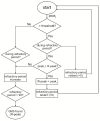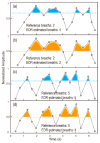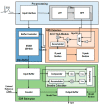A High Accuracy & Ultra-Low Power ECG-Derived Respiration Estimation Processor for Wearable Respiration Monitoring Sensor
- PMID: 36005061
- PMCID: PMC9405792
- DOI: 10.3390/bios12080665
A High Accuracy & Ultra-Low Power ECG-Derived Respiration Estimation Processor for Wearable Respiration Monitoring Sensor
Abstract
The respiratory rate is widely used for evaluating a person's health condition. Compared to other invasive and expensive methods, the ECG-derived respiration estimation is a more comfortable and affordable method to obtain the respiration rate. However, the existing ECG-derived respiration estimation methods suffer from low accuracy or high computational complexity. In this work, a high accuracy and ultra-low power ECG-derived respiration estimation processor has been proposed. Several techniques have been proposed to improve the accuracy and reduce the computational complexity (and thus power consumption), including QRS detection using refractory period refreshing and adaptive threshold EDR estimation. Implemented and fabricated using a 55 nm processing technology, the proposed processor achieves a low EDR estimation error of 0.73 on CEBS database and 1.2 on MIT-BIH Polysomnographic Database while demonstrating a record-low power consumption (354 nW) for the respiration monitoring, outperforming the existing designs. The proposed processor can be integrated in a wearable sensor for ultra-low power and high accuracy respiration monitoring.
Keywords: EDR; QRS detection; processor; wearable respiration monitoring sensor.
Conflict of interest statement
The authors declare no conflict of interest.
Figures










Similar articles
-
An Ultra-Energy-Efficient and High Accuracy ECG Classification Processor With SNN Inference Assisted by On-Chip ANN Learning.IEEE Trans Biomed Circuits Syst. 2022 Oct;16(5):832-841. doi: 10.1109/TBCAS.2022.3185720. Epub 2022 Nov 30. IEEE Trans Biomed Circuits Syst. 2022. PMID: 35737625
-
A 746 nW ECG Processor ASIC Based on Ternary Neural Network.IEEE Trans Biomed Circuits Syst. 2022 Aug;16(4):703-713. doi: 10.1109/TBCAS.2022.3196059. Epub 2022 Oct 12. IEEE Trans Biomed Circuits Syst. 2022. PMID: 35921346
-
A 1.2nW Analog Electrocardiogram Processor Achieving a 99.63% QRS Complex Detection Sensitivity.IEEE Trans Biomed Circuits Syst. 2021 Jun;15(3):617-628. doi: 10.1109/TBCAS.2021.3092729. Epub 2021 Aug 12. IEEE Trans Biomed Circuits Syst. 2021. PMID: 34185648
-
Development of three methods for extracting respiration from the surface ECG: a review.J Electrocardiol. 2014 Nov-Dec;47(6):819-25. doi: 10.1016/j.jelectrocard.2014.07.020. Epub 2014 Aug 4. J Electrocardiol. 2014. PMID: 25194875 Review.
-
A lightweight convolutional neural network hardware implementation for wearable heart rate anomaly detection.Comput Biol Med. 2023 Mar;155:106623. doi: 10.1016/j.compbiomed.2023.106623. Epub 2023 Feb 8. Comput Biol Med. 2023. PMID: 36809696 Review.
Cited by
-
Advances in Respiratory Monitoring: A Comprehensive Review of Wearable and Remote Technologies.Biosensors (Basel). 2024 Feb 6;14(2):90. doi: 10.3390/bios14020090. Biosensors (Basel). 2024. PMID: 38392009 Free PMC article. Review.
References
-
- Yang S., Fan J., Liu J., Chang L., Lin S., Zhou J. A High Accuracy & Low Power EDR Estimation Processor for Wearable Devices; Proceedings of the 2021 IEEE International Conference on Integrated Circuits, Technologies and Applications (ICTA); Zhuhai, China. 24–26 November 2021.
MeSH terms
Grants and funding
LinkOut - more resources
Full Text Sources

